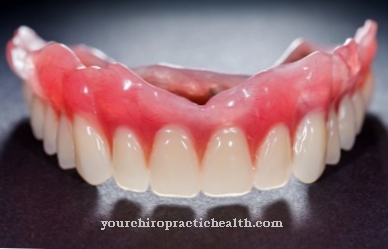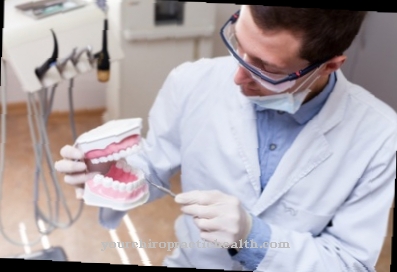It plays in dentistry cement plays an important role as fastening and filling material. Very different materials are used here. The most widely used dental cement to date consists of zinc phosphate.
What is cement

The living tooth already forms a cement in a natural way, which as root cement surrounds the tooth root. The root cement is used to fix the tooth in the tooth holding apparatus and consists of 60 percent hydroxyapatite, 23 percent organic components and 12 percent water. Hydroxyapatite is the same material that bones are made of. It is calcium phosphate.
Materials are also used for the artificial fixation of tooth components, dentures, root fillings and dental fillings in general, which must have strong adhesive properties in order to be able to fix the teeth, crowns, dentures or inlays.
Ideal materials should have good adhesion to teeth and prostheses, high tensile and compressive strength, low solubility in water and acids, rapid loading capacity and good biocompatibility.
Shapes, types & types
Different materials are used depending on the intended use of the dental cements. The actual dental cements contain a high degree of inorganic components. Most of them are zinc phosphates. Some cements have an organic plastic matrix that is filled with inorganic fillers.
Glass ionomer cements, in turn, are made from a mixture of organic polymers and a calcium-aluminum-silicate glass. Zinc phosphate cement, or phosphate cement for short, is still the most widely used dental cement today. It is used to fix crowns, for underfilling and for provisional tooth filling. It also acts as a thermal and chemical insulator.
A zinc oxide-eugenol cement has been used since the 19th century. This consists of a mixture of zinc oxide and eugenol (clove oil). It is particularly used for cementing temporary restorations or root canal fillings. Eugenol causes the typical odor at the dentist.
A so-called glass ionomer cement is also used. Glass ionomer cement is produced on the basis of organic polymers from polyacrylic acid and calcium-aluminum-silicate glass. It is used for fastening crowns, for underfilling and for making fillings for deciduous teeth.
Composites are materials that are often used for fillings. But they are also a suitable material for fastening crowns, roots and ceramic restorations. A mixture of glass ionomer cements and composites forms so-called compomers, which are used as a filling material.
Structure & functionality
The individual cements consist of different materials, which, however, have overall good adhesive properties to the tooth. Due to the inorganic components such as zinc phosphate, zinc oxide or calcium aluminum silicate, they are not adhesives but cements. While adhesives have flow properties and a high viscosity, cements are solids with high compressive and tensile strength. For the cements with organic plastic content, however, a certain plasticity is also required, although the factor of strength dominates.
The cement most commonly used in dentistry is still phosphate cement. It is mixed with a cement powder and a liquid shortly before use. The cement powder consists of up to 90 percent zinc oxide. The remainder is made up of magnesium oxide, calcium fluoride, silicon dioxide and aluminum oxide as the amount decreases. The liquid is a 45-64 percent phosphoric acid.
These two components are stirred together on a corrosion-free surface. The mixing ratio is chosen so that a creamy consistency is created. After using this paste, the cement quickly sets and fixes the crown or creates a stable tooth filling.
As already mentioned, zinc eugenol cement consists of a mixture of zinc oxide and clove oil. It hardens very quickly and has good flow properties. However, since eugenol dissolves plastics, this cement should never be used for cementing plastic restorations.
The glass ionomer cement is produced by the reaction between polyacrylic acid and calcium aluminum silicate in distilled water. This creates a calcium aluminum carboxylate gel that hardens quickly. Its adhesive properties result from the strong bond between the carboxy group and the hard tooth substance.
Composites represent another class of materials. They consist of a plastic matrix mixed with inorganic bodies. The compomers, in turn, are modified composites to which glass ionomer cements have been added. Both are mainly used as an alternative to amalgam, gold or ceramic fillings. Composites are also used for cementing crowns, ceramic restorations and root posts.
You can find your medication here
➔ Medicines against tartar and tooth discolorationMedical & health benefits
The use of cement in dentistry guarantees full functionality of the dentition even with destroyed teeth and in old age. Many teeth that are no longer alive can be preserved for a long time with the help of crowns and root attachments and thus support the chewing function.
Even complete dentures always require cement with well-adhering materials for attachment. Phosphate cement has proven particularly useful for all applications. It combines all the properties necessary for a good cement. The material has high adhesive properties on the tooth, is characterized by high compressive and tensile strength and is biocompatible. Although a strong acid is used in the production of phosphate cement, it does not damage the tooth.
Glass ionomer cement also has good adhesive properties and is even more pressure-resistant than phosphate cement. However, its moisture resistance is lower. In addition, it is not suitable for use in dead teeth because it needs moisture for its function.Devital teeth, however, are no longer supplied and can therefore no longer supply moisture.
Glass ionomer cement is an alternative to phosphate cement only for vital teeth. In the case of non-vital teeth, you can choose between phosphate cement and composite. Compomers are only suitable for fillings.

























.jpg)


